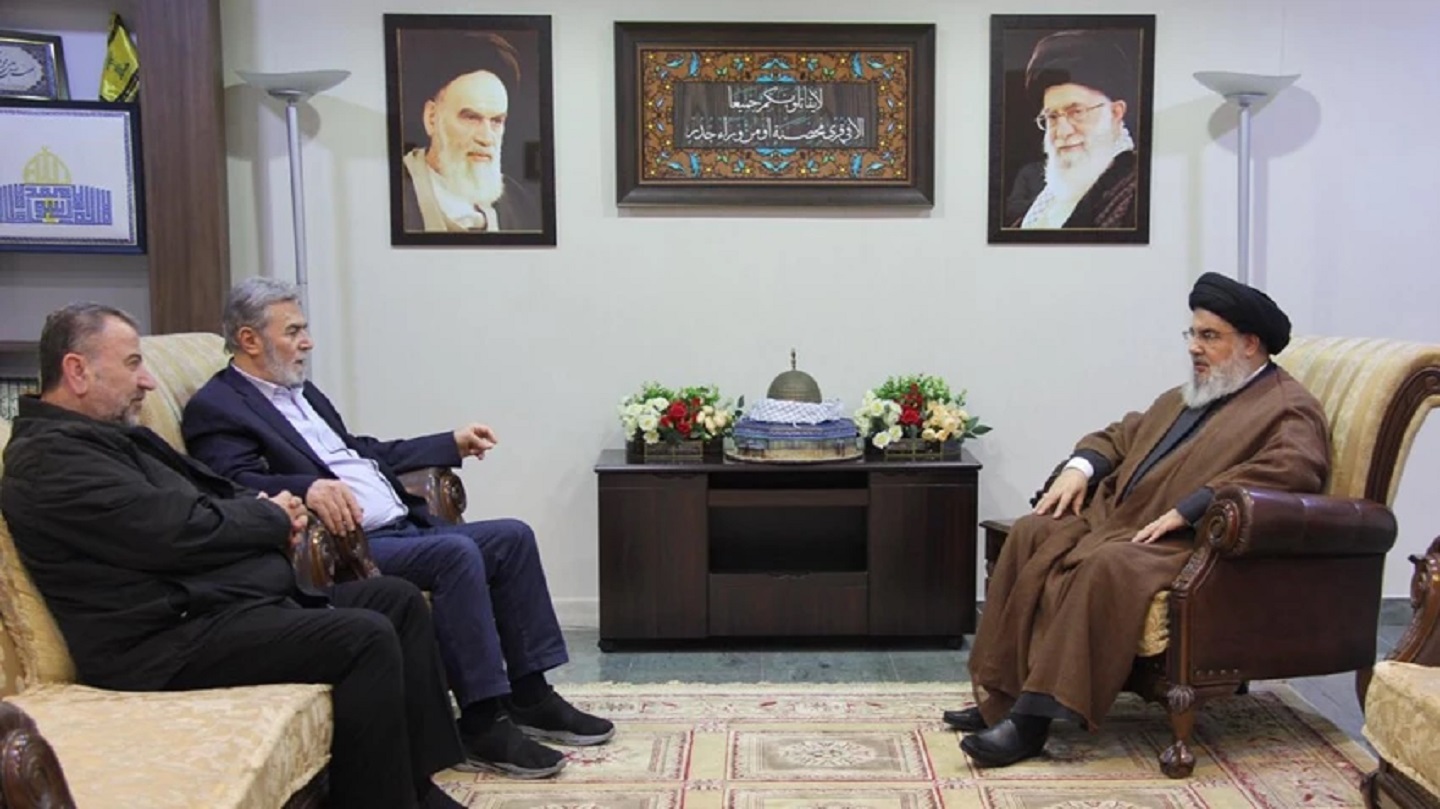AhlulBayt News Agency (ABNA): Hezbollah Secretary General Sayyed Hasan Nasrallah received leaders of Palestinian resistance groups, the group’s media office announced a highly anticipated meeting amid speculations over the Lebanese resistance leader’s silence since Operation Al-Aqsa Flood on October 7th.
Sayyed Nasrallah received Islamic Jihad Secretary General Ziad Nakhale and Hamas deputy chief Saleh Al-Arouri, Hezbollah’s Media Relation Office announced.
This monumental meeting served as a platform to assess the recent developments in the Gaza Strip, tracing back to the commencement of Operation Al-Aqsa Flood and its subsequent ramifications at all levels, while also addressing the ongoing confrontations along the Lebanese-Palestinian border.
“The leaders tackled latest developments since the start of Operation Al-Aqsa Flood and the events that followed on all fronts including the confrontations across the border between Lebanon and the occupied Palestine,” the statement, obtained by Al-Manar read.
At the heart of the discussion was a comprehensive review of both international and regional stances. The triumvirate of the resistance explored the necessary strategies and actions to be undertaken during this critical phase.
“Sayyed Nasrallah assessed with Nakhale and Al-Arouri the international and regional stances as well as steps to be taken by the Axis of Resistance in this critical phase in order to achieve an all-out victory and to stop the brutal attack on the oppressed people of Gaza and the West Bank.”
About the Tableau
A photograph from the gathering revealed a tableau that encapsulated the spirit of resistance and highlighted the vulnerabilities of the enemy. The tableau featured Quranic verses that serve as a symbol of the resistance’s strength, with the passage, “They will not fight you all except within fortified cities or from behind walls.”
Adding to the rich symbolism, an embodiment of the Dome of the Rock, an iconic Palestinian landmark, graced the table, adorned with a kufiya, a symbol of Palestinian heritage and resilience.
Flanking this emblematic centrepiece were two flower vases, each displaying flowers in the colors of the Palestinian and Lebanese flags (white, green, and red).
...................
End/ 257
Hezbollah Secretary General Sayyed Hasan Nasrallah received leaders of Palestinian resistance groups, the group’s media office announced a highly anticipated meeting amid speculations over the Lebanese resistance leader’s silence since Operation Al-Aqsa Flood on October 7th.
Sayyed Nasrallah received Islamic Jihad Secretary General Ziad Nakhale and Hamas deputy chief Saleh Al-Arouri, Hezbollah’s Media Relation Office announced.
This monumental meeting served as a platform to assess the recent developments in the Gaza Strip, tracing back to the commencement of Operation Al-Aqsa Flood and its subsequent ramifications at all levels, while also addressing the ongoing confrontations along the Lebanese-Palestinian border.
“The leaders tackled latest developments since the start of Operation Al-Aqsa Flood and the events that followed on all fronts including the confrontations across the border between Lebanon and the occupied Palestine,” the statement, obtained by Al-Manar read.
At the heart of the discussion was a comprehensive review of both international and regional stances. The triumvirate of the resistance explored the necessary strategies and actions to be undertaken during this critical phase.
“Sayyed Nasrallah assessed with Nakhale and Al-Arouri the international and regional stances as well as steps to be taken by the Axis of Resistance in this critical phase in order to achieve an all-out victory and to stop the brutal attack on the oppressed people of Gaza and the West Bank.”
About the Tableau
A photograph from the gathering revealed a tableau that encapsulated the spirit of resistance and highlighted the vulnerabilities of the enemy. The tableau featured Quranic verses that serve as a symbol of the resistance’s strength, with the passage, “They will not fight you all except within fortified cities or from behind walls.”
Adding to the rich symbolism, an embodiment of the Dome of the Rock, an iconic Palestinian landmark, graced the table, adorned with a kufiya, a symbol of Palestinian heritage and resilience.
Flanking this emblematic centrepiece were two flower vases, each displaying flowers in the colors of the Palestinian and Lebanese flags (white, green, and red).
....................
End/ 257

